Drywall niches in interior design

Room decoration can be done in a variety of ways. One of the best ways to diversify your interior is to use drywall niches. But it is important to apply this material as correctly as possible in order to achieve the highest efficiency of this stylish design.


Peculiarities
Drywall can be considered one of the best building materials. Rare repairs can be carried out without using its sheets. There are a large number of available options for its application - ceilings with one and several levels, slopes, smooth walls, partitions and screens. Among these and many other options for using drywall, the niche does not take the last place.
The advantages of GCR are quite obvious:
lack of toxic properties;
strictly standardized sizes;
the ability to use in a variety of conditions;
ease of decoration.

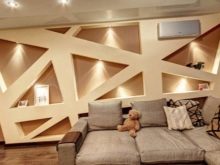

A gypsum board is always 120 cm wide and either 250 or 300 cm long. The material used for the walls is 1.25 mm thick.
On the ceilings there is a thinner gypsum board (0.95 cm), and for the arches an even thinner version is needed (0.65 cm).


Plasterboard niches are much better than the usual exquisite furniture, because they allow you to abandon bulky hanging shelves and shelves, from stands of the original form. Such designs are not very practical, they are not suitable for every interior and often serve only as dust concentrators. With the help of recesses, it is easy to place the most important and pleasant things for people on the walls, give them a new sound and radically change the atmosphere in the room. In addition, the appearance of a room can be altered very quickly and at minimal cost.


Views
With the help of niches, you can place, for example, a cornice for hanging curtains, curtains. The hidden version of such a device cannot be seen from the outside, the observer discovers only canvases descending from somewhere above. No distractions!
The portal is most often formed on the basis of galvanized profiles, the wall is prepared in advance and sheathed with the original layer of gypsum board. To create niches, it is recommended to use sheets 1.5 cm thick, because the individual elements of such recesses can be large and are designed to withstand hanging TVs and other structures weighing up to 10 kg.


It makes sense to illuminate niches for refrigerators inside, placing a strip of built-in LEDs under the very edge of the ceiling. As with creating other lighting options, the location of the wiring should be made as close as possible to the available power supply.
You can also hide in niches:
corner wall;
closet;
curtains and a battery.



Design
The functions of niches and partitions can be summarized in four main areas:
elegant design element;
comfortable, practical location for items;
division of space into sections;
savings on furniture.
Decorating a blank wall with plasterboard niches allows you to place TVs and decorative fireplaces in them. In these recesses there is room for ornamental plants, large furniture and book collections. Spectacular LED lighting helps to complete the formation of a beautiful space.
If you supplement the territory with a cozy sofa, add textiles, you can achieve a very stylish appearance.

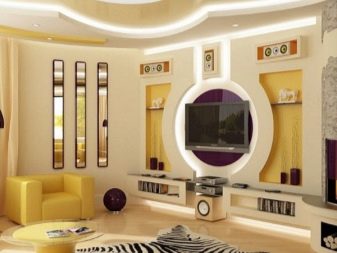


An attractive design move - crushing the territory with partitions (for example, the separation of the work and recreational areas in the children's room or in the home office). By combining the creation of a barrier with niches, it will be possible to lighten it and reduce the load on the supporting elements. It is easy to put a flowerpot, children's toys and other not too significant items in the recesses. Decorative niches allow you to install a dressing room or wardrobe in a variety of rooms - the same bedrooms, nurseries, halls and corridors. To complete the creation of a full-fledged storage area, you will only need to mount outward opening or sliding doors.



A niche in the apartment, combined with a decorative screen, disguises well the most unsightly heating radiators. But they may have another task, which is successfully solved by a niche in the format of a shelf. Such products fit easily in the kitchen and living room, in the bathroom, in the corridor and on the balcony. They allow you to arrange a variety of objects and set a clear accent for the entire interior of the room. Improving the preservation of an attractive appearance allows the use of a moisture-resistant type of gypsum board.




For finishing drywall, especially those mounted in a bathroom or kitchen, it is recommended to use acrylic facade paints that effectively resist moisture ingress and mechanical destruction. Sometimes the walls are lined with tiles, mosaic tiles are preferable for bathrooms. Most of the design developments are complemented by luminaires, among which the LED lamps are the most appreciated. The reason is not only their cost effectiveness, but also their increased safety in comparison with other options.
Large shelves, where many items are exhibited, are best placed behind the door. Then the seeming chaos will not embarrass those who come to such a living room, and the household members themselves will not annoy.


How to do it yourself?
Step-by-step instructions for making a drywall niche always begins with the preparation and collection of the required material part.
Home craftsmen will need:
several guides (made of wood or metal);
drywall sheets;
construction level;
screwdriver and drill;
dowels and screws;
putty;
putty knife.
The installation of the frame must comply with the drawings; the guides are fastened to the walls using dowels, they can be pulled together with self-tapping screws. However, the structures included in the metal profile can also be connected with a riveter. This option allows you to avoid cracking drywall or insufficiently tight fit to the guides.



Sheets placed on the frame are sheathed with plasterboard and putty. The options for subsequent finishing are quite diverse. This is painting, and wallpapering, and the use of decorative stone, and cladding with ceramic tiles. Shelves installed in addition to niches can be wood or glass. The decision must be made in accordance with the dominant style in the room. All that remains is to place the desired interior items there and enjoy the result.



Preparing a niche for installing a TV with your own hands is quite possible. For work, you will need aluminum profiles (ceiling and wall, guides and flexible). You will definitely need a number of hangers, connecting components, corners and extension cords. GKL and profile are fixed with self-tapping screws, sometimes dowels are used. In most cases, you can get by with typical sheets of drywall, but situations are possible when arched material is required.
GKL will need to be putty and primed, and all seams and joints are sealed with serpyanka tape.



Before the manufacture of a plasterboard niche begins, it is necessary to clearly determine whether it will protrude outward or recessed inward. The second method will require covering a significant part of the wall with sheets of material, but this solution makes the space more expressive.
It is equally important to choose the configuration of the element being created:
rectangular (horizontally or vertically);
square;
oval;
curved shape;
original design.



The principles are well known to everyone - if the line is extended upward, it will help raise the ceiling, and if it is directed horizontally, it will expand the walls that are too narrow. Atypical geometry is justified only if the room itself has a different shape from the typical one. But with the usual straight walls, various experiments are not always compatible, and if they can be carried out, then only at the direction of an experienced designer.



To improve the area around the TV, you can make a row of shelves for sound equipment and decorative items. Often they create shelves or cabinets, which together with a niche form a solid ensemble. Important: from the back of the TV to the niche, always leave 50-70 mm so that you can safely place cables and provide ventilation. Free space should also be left around the perimeter of the screen.



When installing the guide profiles, the dowels can be placed at a maximum of 0.4 m from each other. Then comes the turn of vertical parts (ceiling and floor). The frame is covered with plasterboard gradually, and first of all they work with the most complex elements. The self-tapping screws are placed at a distance of 25-30 cm.
In addition to the primer, putty and serpyanka, you need to use a metal corner with perforation (they cover the outer edges).
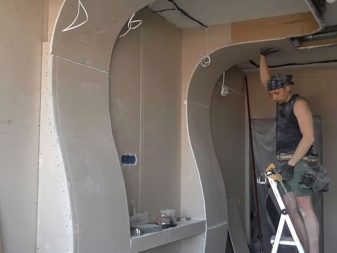

How to arrange?
The ideal placement of a drywall niche in a room requires familiarization with the basic design principles. Most often, such structures occupy the center of the room, although they can be made on the longest or accent wall. If the room has an empty corner or other unused space, this is where the recess should be mounted. In the bedroom, a spacious niche with shelves becomes a replacement for a sliding wardrobe and you need to put it in the same place where it stood before.
There are other recommendations:
- in the bathroom, it is advisable to place a niche either against the far wall, or deepen it into the side plane (so as not to absorb space);



- in the hallway, it is worth placing this structure opposite the front door a few steps from it, so that it is easier to fold and take things;
- in the kitchen, the optimal location of the recess is the place where the TV will be located, since it is for it that the recess is mainly prepared;
- in the bedroom, it would be a good idea to install a structure in which the bed will fully or partially hide;
- in the corridors where an unused corner remains, there is no need to look for a place to work with drywall sheets.

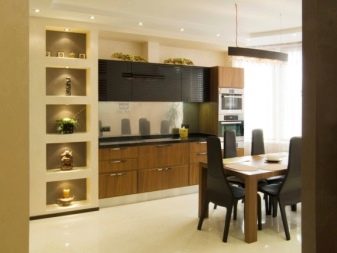


Tips & Tricks
The device of drywall niches is possible in any room, but in order to avoid mistakes, you should pay attention to the type of material. The standard coating is marked as GKL gray with blue marking. Red marking indicates increased fire resistance (GKLO), and a green plate with red marks is both moisture and flame resistant.
In a one-room apartment, a niche will allow you to hide certain objects or certain parts of the space, this approach is used very often.


It is recommended to complement plasterboard niches with elegant things., including antique ones. If it is not possible to purchase new interior items, you can rearrange the existing ones, sometimes the effect is very attractive. Putting a TV in a niche in the living room and supplementing it with several armchairs, you can feel yourself in a non-standard setting.
With the help of the recess, you can change the impression of the bedrooms, adjust the placement of furniture in them. In kitchens, such a decoration element can add space, which is very important in small apartments.


The classic solution is a combination of niches with partitions and arches from the same drywall.The walls, complemented by grooves, allow for optimal working conditions when a teenager lives in the house. It is easier than creating furniture combinations, setting up screens, placing curtains or interior doors. But in order to avoid mistakes, it will be necessary to study the workflow well enough, otherwise the strength of the structures will be insufficient and they will not fulfill the task.



It is advisable to properly prepare for work, to level the surface of the walls as much as possible, which will become a support for the structure being created. Otherwise, even true professionals will not be able to guarantee its strength. Plumb line markings are the simplest solution, but it is much better to align all lines using a laser level. During the installation process, the level and plumb line are the first assistants of any master. Only they will allow avoiding distortions and quick destruction of the created decor.


The screw hats should go deep into the drywall, but by a maximum of 0.2 cm. This will allow them to hold firmly and not to disturb the structure of the material, not to weaken its load-bearing properties. Saving on the use of sheets for external cladding is a stupid thing, because the imaginary benefit is destroyed by not too good appearance and insufficient niche strength. If additional finishing will be carried out, ceramic tiles should only be resorted to as a last resort. Lightweight wallpapers are much better suited for decorating drywall.


Beautiful examples in the interior
A plasterboard niche can be decorated with the same color that was used to decorate the ceiling in the room. A stepped niche with shelves, in the free part of which a flat TV is suspended, looks very, very attractive. But TV isn't the only option. The photo shows how attractive the appearance of identical square niches is, in the upper part of which a point source of directional light is installed.
A uniform, monotonous color does not limit the designers' imagination. The floral ornament looks very good both with and without illumination.

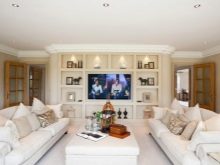

For information on how to make a drywall niche, see the next video.













The comment was sent successfully.